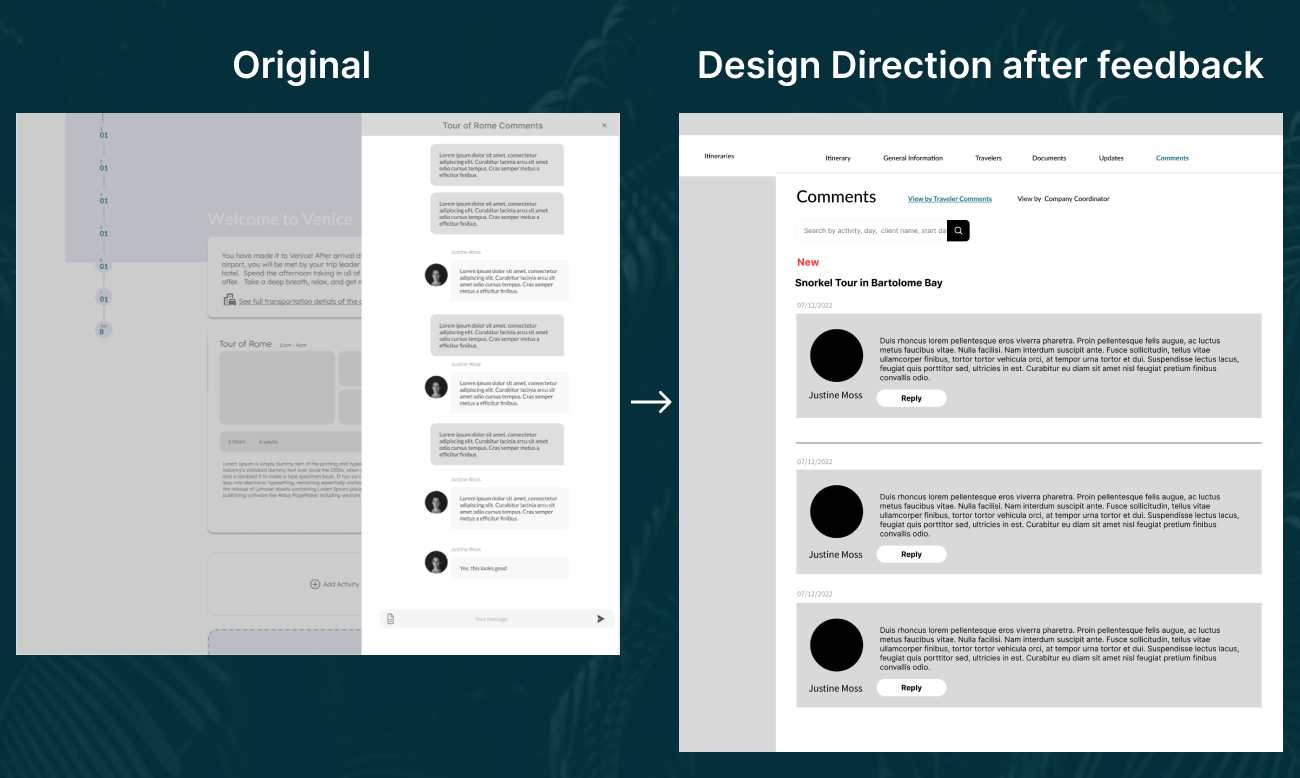.png)
My Role
Assisted in UX Strategy: Comparative analysis, Survey, Data Synthesis, Feature Tables, JTBD
Design Lead: Wireflow, Lo-fi, Mid-fi, High-fi, Prototype
Team
UX/UI Designer, a UX Researcher, and Developer
Company
Ecomadic A company like Airbnb but for travelers who want to travel with sustainable accommodations and experiences.
Duration
16 Weeks
Design Tools
Figma, Whimsical, Zoom, and Survey Monkey
All-in-one itinerary building system for travel curators
The "problem"/Challenge
It was only natural that sustainable travel platform Ecomadic would move into the travel curator space with their own itinerary building platform. Travel Curators (much like a travel agent) would be able to build and manage itineraries, create invoices or quotes, message clients, have a client database, and create event modules for easy itinerary building.
Opportunty
To understand what curators want most out of the itinerary building process while also focusing on how we can turn their needs into a superb experience that can potentially drive new customers and increase revenue for Ecomadic.
How I got from the “problem” to the actual problem
General Market Research + Survey
I wanted to understand the travel industry: its trends, the verbiage used, and the behaviors of customers and businesses. After learning generally about the travel curator and their role in the industry, I wanted to get a basis for who my user is, what is important to them in the itinerary building process, and whether or not something as simple as an integration from an existing product would be a good fit.
- I used Survey Monkey to create the survey.
- Ecomadic’s stakeholder provided a list of travel curators that are on our waitlist to use the product.
.png)
If the curators are using existing platforms to create their itineraries, why would they also need to use Google Suite and email?
Interviews
I needed more clarity so I interviewed 6 of the travel curators on Ecomadics waitlist.
.png)
Competitive Analysis + the Gap + A New Opportunity
The competition had NO EFFECTIVE COMMUNICATION aspect.
Since I didn’t have access to our direct competitors' backend itinerary builders, we opted to analyze itinerary builders available to anyone.
While keeping my other research in mind, I analyzed the 4 most popular itinerary builders. I found that almost none of them had this aspect of effective communication. This then became my opportunity for the solution.

How Might We's
.png)
Design
Setbacks + a new direction for effective communication
At first I spent 1 week trying to play with a couple of directions: communication system synched with your phone, synching with google suite, etc. But after presenting my initial ideas to the dev team, it became clear that those would take too long to implement, especially for the first MVP. So I decided to stick with a simple messaging system within the platform. During the presentation we also noticed that our initial scope was too much for the time allotted. It would have been nice to include everything in the designs (invoices, inquiries, payment system, event modules, etc.), but ultimately decided to focus my energy on creating effective communication through the itinerary builder itself and forget about the bells and whistles.
Testing + Improvements
2 major improvements to my design
Based on various feedback from 6 curators, I continually iterated my design over the span of 4 weeks with 2 major improvements:
01Redesigned how curators add events to their itinerary
- Originally designed the builder portion to reflect how the itinerary was going to look like to the traveler
- Upon feedback, it was hard for the user to keep track of all the events and details.
- Users stated that building an itinerary step by step with as little distraction as possible was important
.png)
02Switching to a separated commenting system:
- Originally, the comments were accessible to the curator on the itinerary itself based on activity.
- Based on the feedback, the comments section was confusing for users. They were worried that it was too much to manage and click into for each activity. I put the comments in the dashboard area and grouped the comments by travelers and Company Coordinators.
- Allows for organization and flow of communication between the three parties as travelers did not need to see what Company Coordinators had to comment on (for curator only).

The Final Screens
.png)
.png)